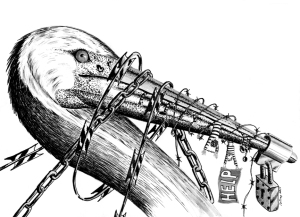Tagged: Milk Not Jails
Listening to the Silence In California
On July 7th, an enormous mobilization began. 30,000 people initiated one of the most powerful means of non-violent action, a hunger strike. Across the face of California, these men and women of conscience are protesting the psychological torture of 12,000 people held in solitary confinement in that state. You may not have noticed. That is because this mass-movement is being waged by inmates themselves.
 The daily refusal of food continues invisibly beneath the humdrum screech of popular news, as if Market St of San Francisco was carpeted in a silent sit-in while traffic exploded with car alarms. But today, the 11th day without food, is also a day of celebration for survivors of solitary confinement and opponents of all systems of racial injustice: Nelson Mandela’s birthday. This man, who survived 27 years of prison, repeated solitary confinement and multiple hunger strikes, was released in 1990 to become his country’s president. His obstacles, struggle, and victory can help link the silent refusal in California, with the righteousness already blaring in our cities.
The daily refusal of food continues invisibly beneath the humdrum screech of popular news, as if Market St of San Francisco was carpeted in a silent sit-in while traffic exploded with car alarms. But today, the 11th day without food, is also a day of celebration for survivors of solitary confinement and opponents of all systems of racial injustice: Nelson Mandela’s birthday. This man, who survived 27 years of prison, repeated solitary confinement and multiple hunger strikes, was released in 1990 to become his country’s president. His obstacles, struggle, and victory can help link the silent refusal in California, with the righteousness already blaring in our cities.
The acquittal of George Zimmerman has reignited protest across the nation, and revived memories of past injustices, Oscar Grant, Rodney King, and in particular Emmet Till and the twisted rationality of lynching. The comparison with lynching is compelling: Ida B. Wells’s famous anti-lynching work counted 159 lynchings in 1893, 241 in 1892. Lynching was defended by the infamous ‘myth of the black rapist,’ even though the majority of lynchings were not instigated by charges of rape.[1] For our own times, a recent study counted 313 extrajudicial shootings in 2012, 51% of which were justified because the officer felt threatened or the victim fled.
But another comparison is possible. In an interview yesterday, Michelle Alexander pointed out that “[…] what George Zimmerman did is no different than what police officers do everyday as a matter of standard operating procedure.” The procedure she refers to is a combination of policing tactics, legal police discretion, and latent racial bias which cause massive racial disproportions in stops, arrests and charges.[2] In combination with racial bias in the judiciary, profiling like Zimmerman’s leads the U.S. to imprison “a larger percentage of its black population than South Africa did at the height of apartheid.”[3] The current system of racial injustice is neither the Old Jim Crow nor South African apartheid, but both are fair comparisons.
South African police shot and killed 211 people in 1983, 199 in 1982. most of whom were black. Apartheid law gave broad discretion in the use of lethal force, sanctioning its use to stop a fleeing suspect, or on a reasonable suspicion of committing a crime. Unlike American lynch mobs, the South African police force was nearly half racial minorities, more diverse than the U.S. police force in 2007.[4] The U.S. in 2012 is not 1980s South Africa, nor 1890s U.S., nor even 1980s U.S. for that matter. But for everyone fighting yesterdays injustice for a just today, we cannot miss opportunities for comparison. Despite obvious differences these three systems are bound together by an indifferent acceptance of racial ideology: the black rapist, the threat to securing Apartheid, and the criminalblackman.
We cannot afford indifference to torture of people labeled gang members. We cannot afford to be blind to the hunger strike which continues as Gov. Jerry Brown goes on vacation. We must take action against the torture of solitary confinement locally to break through the national white-noise.
Thank you to everyone at Milk Not Jails for helping inspire this entry.
[1] Angela Davis. Women, Race And Class . (New York: Vintage Books, 1981), 187.
[2] A 1990s study “showed that only 15 percent of all drivers on the New Jersey Turnpike were racial minorities, yet 42 percent of all stops and 73 percent of arrests were of black motorists—despite the fact that blacks and whites violated traffic laws at almost exactly the same rate […] [and that] in New Jersey, whites were almost twice as likely to be found with illegal drugs or contraband as African Americans […]” Michelle Alexander. The New Jim Crow: Mass Incarceration in the Age of Colorblindness. (New York: The New Press, 2012), 133.
[3] ibid. 6
[4] Roger Omond. The Apartheid Handbook: A Guide to South Africa’s Everyday Racial Policies. (Harmondsworth, Middlesex, England: Penguin Books Ltd., 1985), 136-8.